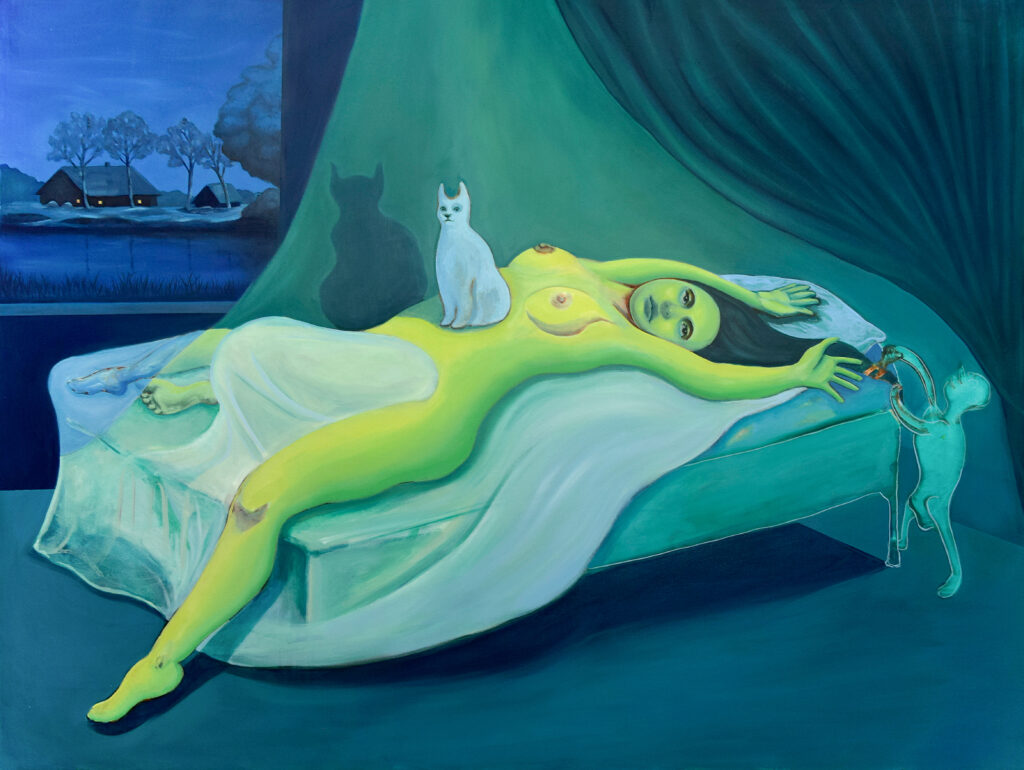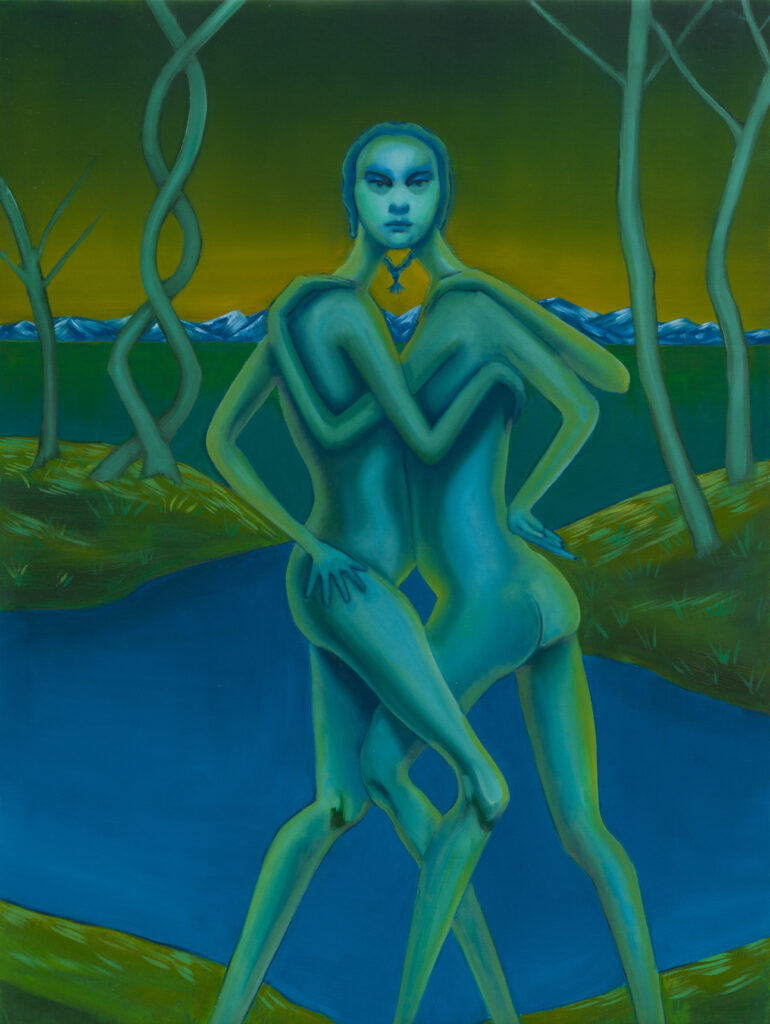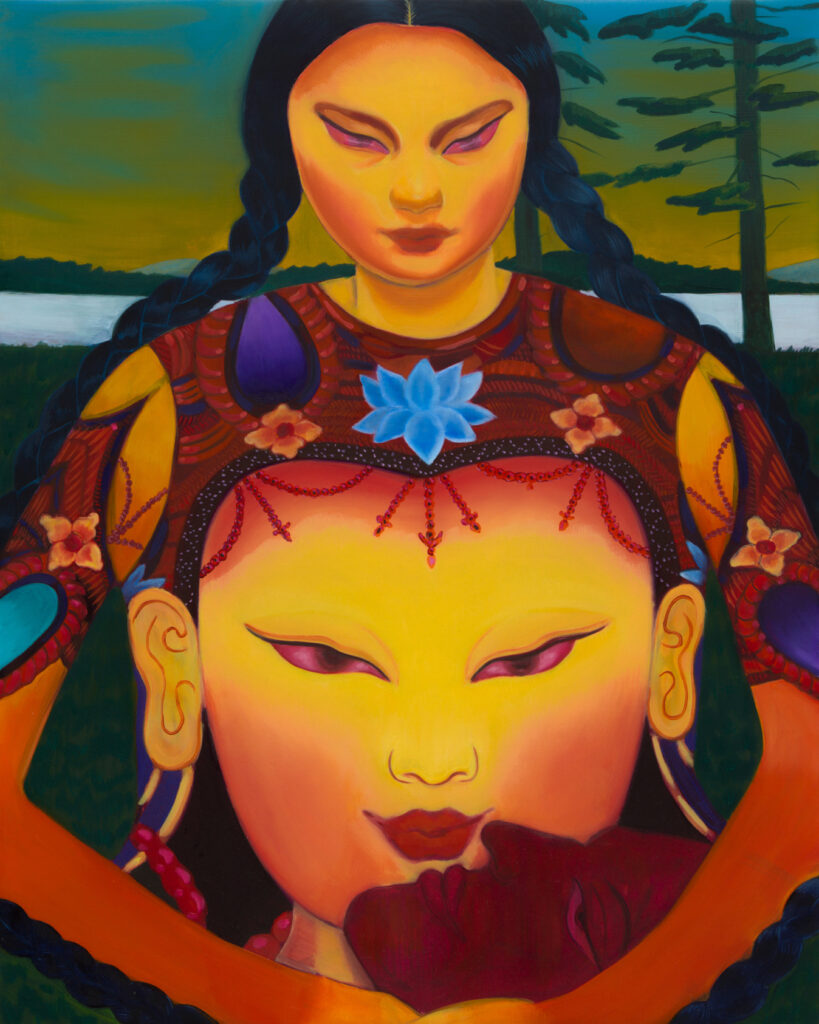Les Dîners de Mamito, 2022
Painting and the challenge of storytelling
Bambou Gili’s paintings are world-building projects, sprawling in narrative and unified by rich, tight colour palettes. Throughout her body of work, fantastical landscapes activate the feminine figures inside them, allowing for nature to become an ally, a co-conspirator, a unique character in and of itself. In each series, the artist — whose inspirations range from the animation of Hayao Miyazaki to the French Impressionists — dives into a singular colour spectrum to experiment freely and tap into possibility. Oil drippings in green, blue or purple produce a textural, eerie stillness that moves across tableaux like an omniscient spectre. Gili’s surrealistic scenes, imbued with this energy, are both clandestine and playful: lush plants, serene bodies of water and ethereal trees conceal subjects from one another as their concurrent stories unfold, and each protagonist exudes a presence that matches the magnitude of her surroundings. Within Gili’s alternate universe, environment and human emotion vibrate at an equal frequency somewhere between waking and dreaming.
The Face Stealer’s Pond, 2021
Your paintings deliver an intriguing sense of mystery, a haunting quality,sometimes spectral but in some cases almost ironic. The subjects are oftenwomen portrayed in nature or domestic settings. One particular work or yours, Sleep Paralysis(2021)reminds me of The Nightmare by Heinrich Füssli(1781), while others bare similarities with the secret forests of Rousseau. Beside arthistorical sources, what are the inspirations behind your works? Do you look at peoplefrom your personallife,photographs,magazines,socialmedia?
Yes! Neighbourhood Sleep Paralysis was based off of Nicolai Abildgaard’s Nightmare (1800), after Heinrich Füssli. Regarding inspiration, nothing is off-limits. I tend to gravitate towards working in series. I like to focus on an idea for a long period of time and see what bodies of works come out of it. While I’m doing research for that idea, I scour everything. If I see something that makes me think of the series, I document it and store it in my series folder. So, take my last one — I was looking at imagined scenes from Calvino’s Nonexistent Knight, 14th-century armour from the MET collection, Scooby Doo stills, etc.

Neighborhood Sleep Paralysis, 2020
While looking at your works one can clearly notice the predominance of blue and green, applied both for living figures as for landscapes. Where does this fascination with these tones come from?
Ha! I get this question a lot. Fun fact: In Zulu, ‘blue’ and ‘green’ are the same word. When I go to the MET, I’ll end up staring at a bright green Lisa Yuskavage painting, admiring the use of colour.
In my last solo, The Non-Existent Night, the series started as an exercise to focus on colour at night. A way to consciously limit my palette to greens, blues and purples. That’s not to say I want my next series to focus on these tones exclusively.
Aggie & Pieter, 2022
Talking about light work and how important it is for you, I was reminded of theimpressionists, who often tried to capture the same subject under different light. Can you tell me something about this study of light and how you incorporate it inyour practice?
Light at night is notoriously hard to capture. You don’t often see a true representation of lowlight scenes. Photos and videos often do a bad job portraying those blues. Which is what led to my night series.
I find the dichotomy of timeframes in your work very interesting: on the one hand, the depicted subjects don’t belong to a specific era historically, on the other, they’re located in the specific — and narrow — time frame of the night. How do you look at time when addressing a new series? Is there a straight conceptionoflinearity?
Honestly, I have not thought about it! I think that the red thread here is the fact that all humans have experienced the night.
I had the pleasure of seeing a preview of your new series, which you willexhibit in your next solo show at Night Gallery (LA) in March. Can you explain the inspiration behind it and how you shaped it through paint?
The work is based on, built around Goodbye Earl, a country song by the [Dixie] Chicks. It’s an upbeat tune, just four minutes or so, but as you listen, you’re introduced to an entire saga — two childhood friends grow up together in a rural area. One moves out, the other stays. The one who stays ends up in an abusive relationship and, try as she might to leave, can’t seem to escape. Well, after exhausting legal outlets, she falls back on her old friend, who returns and helps hatch the plan…Earl has to die.
Now, the thing that intrigued me about the song was the storytelling. They manage to build this entire world — give you details about the friendship, walk you through a murder, get you on their side — in a matter of minutes. Not a movie or a six-part series, but a short song. But somehow, there’s considerable depth, a lot of colour to the story and the characters.

Mind-Body-Body Problem (After Junji Ito), 2022
As a painter, I thought that’d be an interesting challenge. Can you, like The Chicks have done in a song, tell a story in a series of paintings? A story you physically walk and move through? And more than just illustrating a story, can you express the same depth? Have it stand on its own — draw you in, intrigue you, where is this going? ‘Oh shit! But, wait, oh yes, let’s go’. In short, can it move you the way the song does? A world-building exercise.
Storytelling is thus pivotal to your work. Whether it’s to convey a specificsense of mystery, like in the 2020-22 series on the night, or an actual concatenation of events, a single painting exists in relation to the other. Thinking in these terms, what was the difference between your old works and this last series?
Surely there’s some stylistic coherence. So they’re loosely related. But I mean, every year of my life you could ask me to look back two years in the past, and I’d be slightly embarrassed of who I was and what I was doing. You could read that really pessimistically, but the way I see it…if you’re not feeling that way, you’re not evolving.
Blue Kitchen, 2021
While talking about your upcoming show, you told me that the theme of the song slowly became close to your personal life while you were painting the series. In what sense do you think that this song by the Chicks and your translation of it in paint can be relevant for yourself and for collective society, women in particular?
Making the works, you’re forced to view the Goodbye Earl narrative through the cultural context of 2022. It’s not just an arbitrary story. It’s about friendship, relying on your fellow women, revolution if you will. That if it really has to come down to me or you, well, I’m choosing me, bitch. Fuck you. That rings different after 2022, after overturning Roe. Gives it a stronger bite.
But still, there’s a femininity to the murder. They kill Earl over dinner. Compare that to, say, the Goodfellas painting (from this series) — the opening scene, Pesci, DeNiro and Liotta are driving down a dark road, they hear some bumps in the trunk. They pull over, open the trunk, where there’s a guy, barely alive and covered in blood. Pesci stabs him a bunch, DeNiro shoots him multiple times, and Liotta’s voice-over: ‘As far as I can remember, I always wanted to be a gangster’.
You gotta love that these ladies didn’t want to kill someone, didn’t want to take it there — so when they’re forced to, it’s considered, it’s bloodless. Just a poisoning of peas.
How do you see your work developing in the future?
It’s an opportunity to experiment with new colours, new themes. I hope it feels completely different.

Evil Twin in Vivienne Tam, 2022
Artworks
- Les Dîners de Mamito, 2022. Courtesy the artist and Jeffrey Deitch, Los Angeles Photo: Charles White
- The Face Stealer’s Pond, 2021. Courtesy the artist and Perrotin, New York
- Neighborhood Sleep Paralysis, 2020. Courtesy the artist
- Aggie & Pieter, 2022. Courtesy the artist and Night Gallery, Los Angeles Photo: Nik Massey
- Mind-Body-Body Problem (After Junji Ito), 2022. Courtesy the artist and Lyles and King, New York
- Blue Kitchen, 2021. Courtesy the artist and Arsenal Contemporary Art, New York
- Evil Twin in Vivienne Tam, 2022. Courtesy the artist and Lyles and King, New York